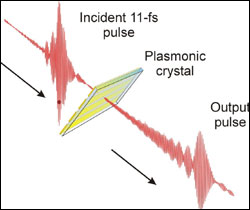This area deals with the fundamental laws and building blocks of nature and how they interact, the properties and the behavior of matter, and research into space and time and their structures.
innovations-report provides in-depth reports and articles on subjects such as astrophysics, laser technologies, nuclear, quantum, particle and solid-state physics, nanotechnologies, planetary research and findings (Mars, Venus) and developments related to the Hubble Telescope.

Pacific Northwest National Lab experiments point to clingy grains of ice to solve age-old mystery of how primordial dust pulled together to form planets
How dust specks in the early solar systems came together to become planets has vexed astronomers for years. Gravity, always an attractive candidate to explain how celestial matter pulls together, was no match for stellar winds. The dust needed help coming together fast, in kilometer-wide protoplanets, in the first few million y

Sandia gas sampling device rapidly determines whether MEMS seals are effective
Just as astronomers want to understand the atmospheres of planets and moons, so engineers want atmospheric knowledge of worlds they create that are the size of pinheads, their “skies” capped by tiny glass bubbles.
Should their silicon inhabitants – microcircuits, microgears, and micropower drivers – exist in a vacuum? An atmosphere of nitrogen? Air as we know it? More importantly, whatever at

The first superconducting magnet for the Large Hadron Collider (LHC) was lowered into the accelerator tunnel at 2.00 p.m. on Monday, 7th March. This is the first of the 1232 dipole magnets for the future collider, which measures 27 km in circumference and is scheduled to be commissioned in 2007. The date was thus a key one for CERN since the delivery of the 15 metre long dipole magnet weighing 35 tonnes to its final location marks the start of LHC installation.
The LHC will c

Astronomers using the European Space Agency’s XMM-Newton telescope have discovered that observing the giant planet Jupiter may actually give them an insight in to solar activity on the far side of the Sun! In research reported in the most recent edition of Geophysical Research Letters, they discovered that Jupiter’s x-ray glow is due to x-rays from the Sun being reflected back off the planet’s atmosphere.
Jupiter is an intriguing object when viewed in x-rays; it has dramatic x-ra

Computer reveals that life around black holes is turbulent and violent
For more than 30 years, astrophysicists have believed that black holes can swallow nearby matter and release a tremendous amount of energy as a result. Until recently, however, the mechanisms that bring matter close to black holes have been poorly understood, leaving researchers puzzled about many of the details of the process.
Now, however, computer simulations of black holes developed by researchers,

Researchers from Berlin and Seoul store light in plasmonic crystals
Light can creep through tiny holes in a metal plate, even if those holes are smaller in diameter than the wavelength of light. What’s more, the light is stored for a short period of time on the metal surface, as if the metal were a photonic crystal. The controlled interaction of light with such metal structures could pave the way to unique methods for nanosensing or nanoscale information transfer, write Claus